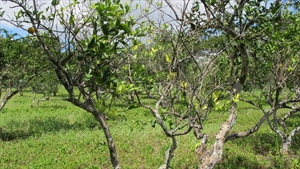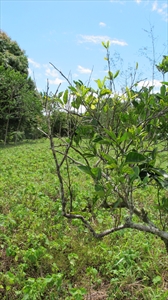- Worldwide distribution. On citrus. An important virus disease, with several strains.
- The virus spreads rapidly on the mouthparts of aphids feeding first on infected and then healthy trees.
- Strains cause: (i) no symptoms; (ii) slow or quick decline of scions (sweet orange, grapefruit, mandarin) on sour orange root stocks; (iii) stem pitting regardless of rootstock; (iv) seedling yellows.
- Biosecurity: not all strains are found in all countries.
- Cultural control: nursery plant certification; remove infected trees; use tolerant root stocks, e.g., trifoliata, Rampur lime, rough lemon, sweet orange. Choose root stocks based on tristeza strains, tolerance to soil pH, and drought.
- Chemical control: it is difficult to control Citrus tristeza virus by killing the aphids that spread it; this is because spread of the virus is fast, and occurs before the insecticide kills the aphid. However, control of aphids in nurseries may be beneficial. Use soap, white or horticultural oils; PDPs: neem, derris, pyrethrum, or chilli; or synthetic pyrethroids, but likely to kill natural enemies






